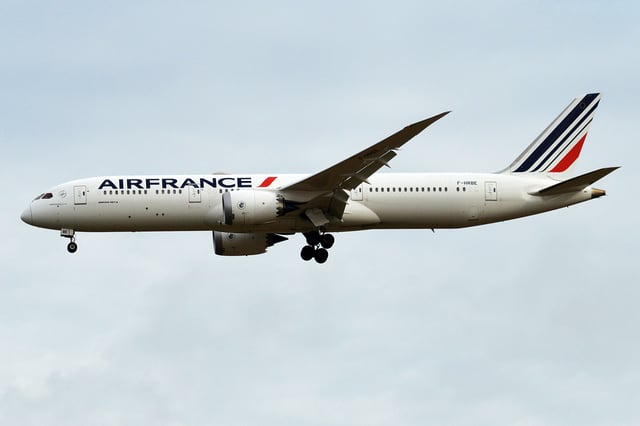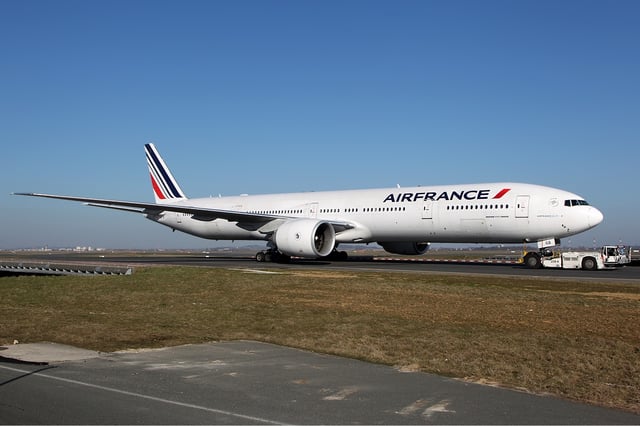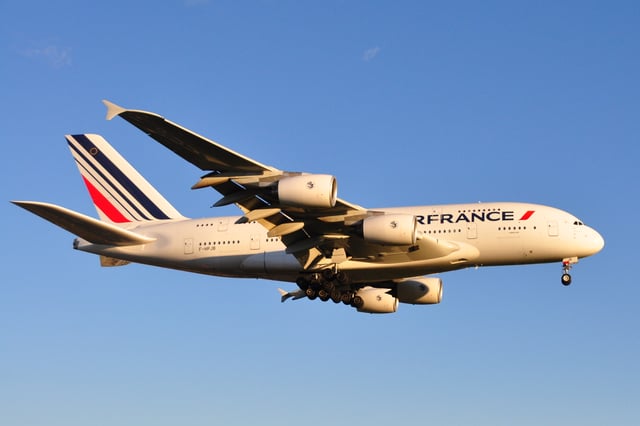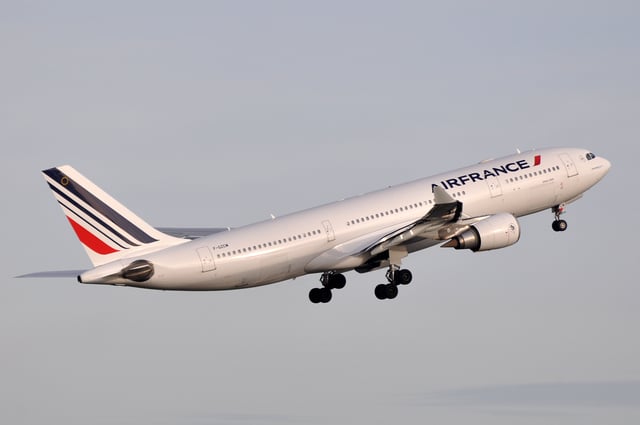Air France
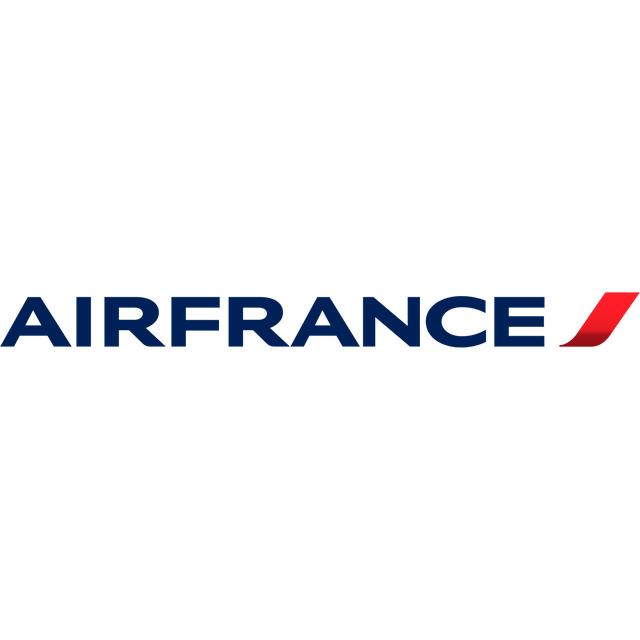
Air France

| |||||||
| Founded | 7 October 1933 (1933-10-07) | ||||||
|---|---|---|---|---|---|---|---|
| Hubs |
| ||||||
| Focus cities |
| ||||||
| Frequent-flyer program | Flying Blue | ||||||
| Alliance |
| ||||||
| Subsidiaries |
| ||||||
| Fleet size | 295 | ||||||
| Destinations | 201 | ||||||
| Company slogan | France is in the air | ||||||
| Parent company | Air France–KLM | ||||||
| Headquarters | Roissypôle, Charles de Gaulle Airport, Tremblay-en-France, France | ||||||
| Key people | Anne Rigail (CEO)[2] | ||||||
| Revenue | €16.1 billion (2018)[3] | ||||||
| Operating income | €266 million (2018)[3] | ||||||
| Employees | 84,602[4] | ||||||
| Website | www.airfrance.com [157] | ||||||
Air France (French pronunciation: [ɛːʁ fʁɑ̃s]; formally Société Air France, S.A.), stylized as AIRFRANCE, is the French flag carrier headquartered in Tremblay-en-France. It is a subsidiary of the Air France–KLM Group and a founding member of the SkyTeam global airline alliance. As of 2013 Air France serves 36 destinations in France and operates worldwide scheduled passenger and cargo services to 168 destinations in 78 countries (93 including overseas departments and territories of France) and also carried 46,803,000 passengers in 2015. The airline's global hub is at Charles de Gaulle Airport with Orly Airport as the primary domestic hub. Air France's corporate headquarters, previously in Montparnasse, Paris,[5] are located on the grounds of Charles de Gaulle Airport, north of Paris.[6]
Air France was formed on 7 October 1933 from a merger of Air Orient, Air Union, Compagnie Générale Aéropostale, Compagnie Internationale de Navigation Aérienne (CIDNA), and Société Générale de Transport Aérien (SGTA). During the Cold War, from 1950 until 1990, it was one of the three main Allied scheduled airlines operating in Germany at West Berlin's Tempelhof and Tegel airports. In 1990, it acquired the operations of French domestic carrier Air Inter and international rival UTA – Union de Transports Aériens. It served as France's primary national flag carrier for seven decades prior to its 2003 merger with KLM.
Between April 2001 and March 2002, the airline carried 43.3 million passengers and had a total revenue of €12.53bn. In November 2004, Air France ranked as the largest European airline with 25.5% total market share, and was the largest airline in the world in terms of operating revenue.
Air France operates a mixed fleet of Airbus and Boeing widebody jets on long-haul routes, and uses Airbus A320 family aircraft on short-haul routes. Air France introduced the A380 on 20 November 2009 with service to New York City's JFK Airport from Paris' Charles de Gaulle Airport. The carrier's regional airline subsidiary, HOP!, operates the majority of its regional domestic and European scheduled services with a fleet of regional jet aircraft.[7]
| |||||||
| Founded | 7 October 1933 (1933-10-07) | ||||||
|---|---|---|---|---|---|---|---|
| Hubs |
| ||||||
| Focus cities |
| ||||||
| Frequent-flyer program | Flying Blue | ||||||
| Alliance |
| ||||||
| Subsidiaries |
| ||||||
| Fleet size | 295 | ||||||
| Destinations | 201 | ||||||
| Company slogan | France is in the air | ||||||
| Parent company | Air France–KLM | ||||||
| Headquarters | Roissypôle, Charles de Gaulle Airport, Tremblay-en-France, France | ||||||
| Key people | Anne Rigail (CEO)[2] | ||||||
| Revenue | €16.1 billion (2018)[3] | ||||||
| Operating income | €266 million (2018)[3] | ||||||
| Employees | 84,602[4] | ||||||
| Website | www.airfrance.com [157] | ||||||
History
Formation and early years
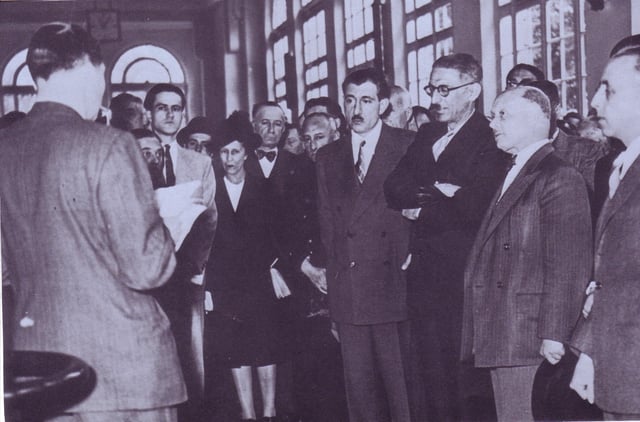
The inauguration of the Aérogare des Invalides on 21 August 1951
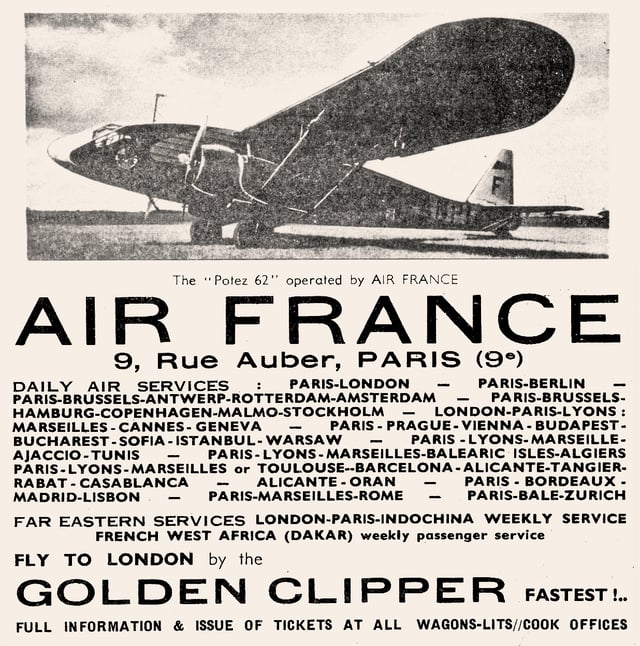
1936 Air France ad for service using Potez 62 twin-engine aircraft.

Air France Douglas DC-3 at Manchester Airport in 1952
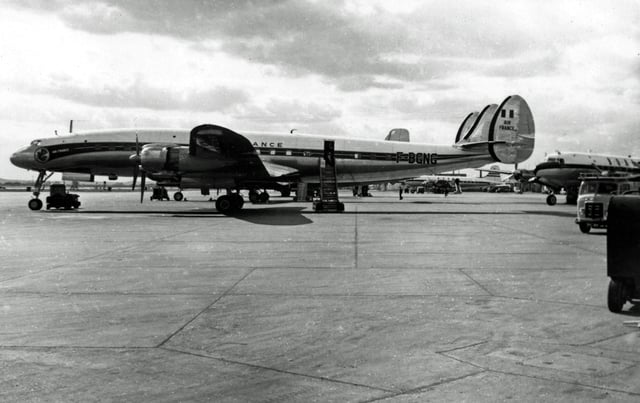
Lockheed Super Constellation of Air France at London (Heathrow) Airport in April 1955
Air France was formed on 7 October 1933, from a merger of Air Orient, Air Union, Compagnie Générale Aéropostale, Compagnie Internationale de Navigation Aérienne (CIDNA) and Société Générale des Transports Aériens (SGTA). Of these airlines, SGTA was the first commercial airline company in France, having been founded as Lignes Aériennes Farman in 1919. The constituent members of Air France had already built extensive networks across Europe, to French colonies in North Africa and farther afield. During World War II, Air France moved its operations to Casablanca (Morocco).
In 1936, Air France added French-built twin engine Potez 62 aircraft to its fleet featuring a two compartment cabin that could accommodate 14 to 16 passengers. A high wing monoplane, it had a wooden fuselage with composite coating while the wings were fabric covered with a metal leading edge. Equipped with Hispano-Suiza V-engines, they were used on routes in Europe, South America and the Far East. Although cruising at only 175 miles per hour, the Potez 62 was a robust and reliable workhorse for Air France and remained in service until the Second World War with one used by the Free French Air Force.[8]
On 26 June 1945 all of France's air transport companies were nationalised.[9] On 29 December 1945, a decree of the French Government granted Air France the management of the entire French air transport network.[10] Air France appointed its first flight attendants in 1946. The same year the airline opened its first air terminal at Les Invalides in central Paris. It was linked to Paris Le Bourget Airport, Air France's first operations and engineering base, by coach. At that time the network covered 160,000 km, claimed to be the longest in the world.[11] Société Nationale Air France was set up on 1 January 1946.
European schedules were initially operated by a fleet of Douglas DC-3 aircraft. On 1 July 1946, Air France started direct flights between Paris and New York via refuelling stops at Shannon and Gander. Douglas DC-4 piston-engine airliners covered the route in just under 20 hours.[11] In September 1947 Air France's network stretched east from New York, Fort de France and Buenos Aires to Shanghai.
By 1948 Air France operated 130 aircraft, one of the largest fleets in the world.[11] Between 1947 and 1965 the airline operated Lockheed Constellations on passenger and cargo services worldwide.[12] In 1946 and 1948, respectively, the French government authorised the creation of two private airlines: Transports Aériens Internationaux – later Transports Aériens Intercontinentaux – (TAI) and SATI. In 1949 the latter became part of Union Aéromaritime de Transport (UAT), a private French international airline.[11][13]
On 4 August 1948 Max Hymans was appointed the president. During his 13-year tenure he would implement modernisation practices centred on the introduction of jet aircraft. In 1949 the company became a co-founder of Société Internationale de Télécommunications Aéronautiques (SITA), an airline telecommunications services company.[11]
Jet age re-organization

Passengers disembarking from a Sud-Est SE-161

Air France Caravelle jetliner in 1977
In 1952 Air France moved its operations and engineering base to the new Paris Orly Airport South terminal. By then the network covered 250,000 km.[11] Air France entered the jet age in 1953 with the original, short-lived de Havilland Comet series 1, the world's first jetliner.
During the mid-1950s it also operated the Vickers Viscount turboprop, with twelve entering services between May 1953 and August 1954 on the European routes. On 26 September 1953, the government instructed Air France to share long-distance routes with new private airlines. This was followed by the Ministry of Public Works and Transport's imposition of an accord on Air France, Aigle Azur, TAI and UAT, under which some routes to Africa, Asia and the Pacific region were transferred to private carriers.[11]
On 23 February 1960, the Ministry of Public Works and Transport transferred Air France's domestic monopoly to Air Inter. To compensate for the loss of its domestic network Air France was given a stake in Air Inter. The following day Air France was instructed to share African routes with Air Afrique and UAT.[11][14]
The airline started uninterrupted jet operations in 1960 with the Sud Aviation Caravelle and the Boeing 707;[11] jet airliners cut travel times in half and improved comfort.[11] Air France later became an early Boeing 747 operator and eventually had one of the world's largest 747 fleets.
On 1 February 1963 the government formalised division of routes between Air France and its private sector rivals. Air France was to withdraw services to West Africa (except Senegal), Central Africa (except Burundi and Rwanda), Southern Africa (including South Africa), Libya in North Africa, Bahrain and Oman in the Middle East, Sri Lanka (then known as Ceylon) in South Asia, Indonesia, Malaysia and Singapore in Southeast Asia, Australia, New Zealand as well as New Caledonia and Tahiti. These routes were allocated to the new Union de Transports Aériens (UTA), a new private airline resulting from the merger of TAI and UAT. UTA also got exclusive rights between Japan, New Caledonia and New Zealand, South Africa and Réunion island in the Indian Ocean, as well as Los Angeles and Tahiti.[11][14][15]
From 1974, Air France began shifting the bulk of operations to the new Charles de Gaulle Airport north of Paris. By the early 1980s, only Corsica, Martinique, Guadeloupe, most services to French Guiana, Réunion, the Maghreb region, Eastern Europe (except the USSR), Southern Europe (except Greece and Italy), and one daily service to New York (JFK) remained at Orly. In 1974, Air France also became the world's first operator of the Airbus A300 twin-engine widebody plane, Airbus Industrie's first commercial airliner for which it was a launch customer.[16]
Concorde service and rivalry
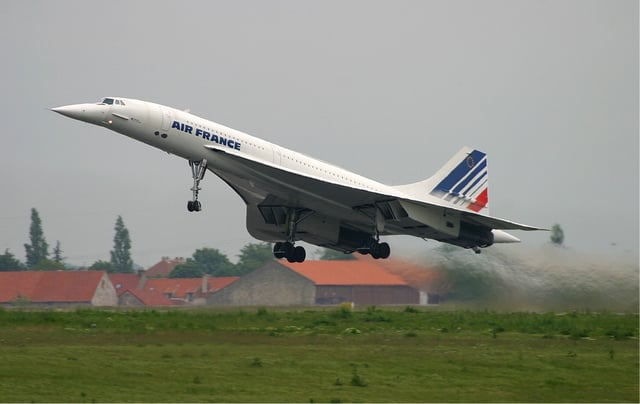
Air France Concorde at CDG Airport in 2003
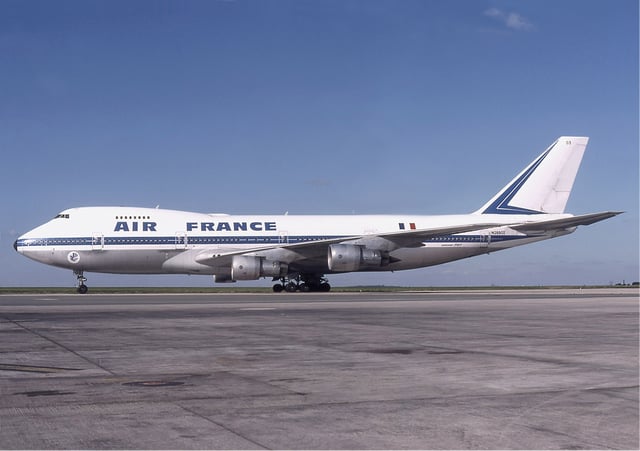
Air France operated 33 Boeing 747s by 1983. Here, a 747-100 is seen at CDG Airport in 1978
On 21 January 1976, Air France operated its inaugural supersonic transport (SST) service on the Paris (Charles de Gaulle) to Rio (via Dakar) route with Anglo-French BAC-Aérospatiale Concorde F-BVFA. Supersonic services from Paris (CDG) to Washington Dulles International Airport began on 24 May 1976, also with F-BVFA. Service to New York (JFK) – the only remaining Concorde service until its end – commenced on 22 November 1977. Paris to New York was flown in 3 hours 23 minutes, at about twice the speed of sound. Approval for flights to the United States was initially withheld due to noise protests. Eventually, services to Mexico City via Washington, D.C. were started. Air France became one of only two airlines – British Airways being the other – to regularly operate supersonic services, and continued daily transatlantic Concorde service until late May 2003.[17]
By 1983, Air France's golden jubilee, the workforce numbered more than 34,000, its fleet about 100 jet aircraft (including 33 Boeing 747s) and its 634,400 km network served 150 destinations in 73 countries. This made Air France the fourth-largest scheduled passenger airline in the world, as well as the second-largest scheduled freight carrier.[11] Air France also codeshared with regional French airlines, TAT being the most prominent. TAT would later operate several regional international routes on behalf of Air France.[18] In 1983 Air France began passenger flights to South Korea, being the first European airline to do so.[19]
In 1986 the government relaxed its policy of dividing traffic rights for scheduled services between Air France, Air Inter and UTA, without route overlaps between them. The decision opened some of Air France's most lucrative routes on which it had enjoyed a government-sanctioned monopoly since 1963 and which were within its exclusive sphere of influence, to rival airlines, notably UTA. The changes enabled UTA to launch scheduled services to new destinations within Air France's sphere, in competition with that airline.[20][21][22]
Paris-San Francisco became the first route UTA served in competition with Air France non-stop from Paris. Air France responded by extending some non-stop Paris-Los Angeles services to Papeete, Tahiti, which competed with UTA on Los Angeles-Papeete. UTA's ability to secure traffic rights outside its traditional sphere in competition with Air France was the result of a campaign to lobby the government to enable it to grow faster, becoming more dynamic and more profitable. This infuriated Air France.[23]
In 1987 Air France together with Lufthansa, Iberia and SAS founded Amadeus, an IT company (also known as a GDS) that would enable travel agencies to sell the founders and other airlines' products from a single system.[24]
In 1988, Air France was a launch customer for the fly-by-wire (FBW) A320 narrowbody twin, along with Air Inter and British Caledonian. It became the first airline to take delivery of the A320 in March 1988, and along with Air Inter became the first airlines to introduce Airbus A320 service on short-haul routes.[25]
Acquisitions and privatisation
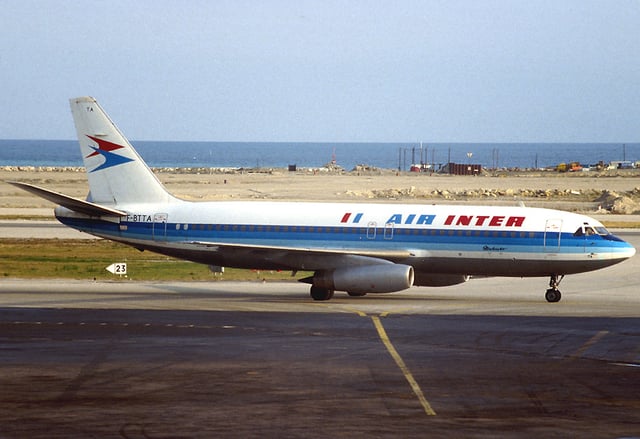
Dassault Mercure of Air Inter which became part of Air France in 1990
On 12 January 1990, the operations of government-owned Air France, semi-public Air Inter and wholly private Union de Transports Aériens (UTA) were merged into an enlarged Air France.[11] Air France's acquisition of UTA and Air Inter was part of an early 1990s government plan to create a unified, national air carrier with the economies of scale and global reach to counter potential threats from the liberalisation of the EU's internal air transport market.[26]
On 25 July 1994, a new holding company, Groupe Air France, was set up by decree. Groupe Air France became operational on 1 September 1994. It acquired the Air France group's majority shareholdings in Air France and Air Inter (subsequently renamed Air Inter Europe). On 31 August 1994, Stephen Wolf, a former United Airlines CEO, was appointed adviser to the Air France group's chairman Christian Blanc. Wolf was credited with the introduction of Air France's hub and spoke operation at Paris Charles de Gaulle. (Wolf resigned in 1996 to take over as CEO at US Airways.)[27][28]
In 1997, Air France Europe was absorbed into Air France. On 19 February 1999, French Prime Minister Lionel Jospin's Plural Left government approved Air France's partial privatisation. Its shares were listed on the Paris stock exchange on 22 February 1999. In June 1999, Air France and Delta Air Lines formed a bilateral transatlantic partnership. On 22 June 2000, this expanded into the SkyTeam global airline alliance.[29][11]
Air France-KLM merger
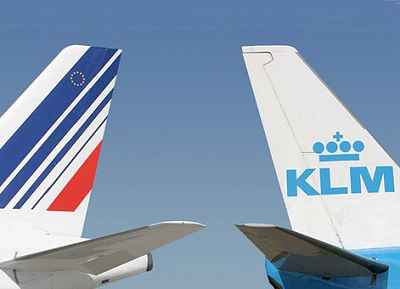
The merger of Air France and KLM occurred in 2004
On 30 September 2003, Air France and Netherlands-based KLM Royal Dutch Airlines announced the merger of the two airlines, the new company to be known as Air France-KLM. The merger became reality on 5 May 2004. At that point former Air France shareholders owned 81% of the new firm (44% owned by the French state, 37% by private shareholders), former KLM shareholders the rest. The decision of the Jean-Pierre Raffarin government to reduce the French state's shareholding in the former Air France group from 54.4% to 44% of the newly created Air France-KLM Group effectively privatised the new airline. In December 2004 the state sold 18.4% of its equity in Air France-KLM. The state's shareholding in Air France-KLM subsequently fell to just under 20%.[29]
Air France-KLM became the largest airline in the world in terms of operating revenues, and third-largest (largest in Europe) in passenger kilometres.[29] Although owned by a single company, Air France and KLM continued to fly under their own brand names. Air France-KLM remained part of the SkyTeam alliance, which then included Aeroflot, Delta Air Lines, Aeroméxico, Korean Air, Czech Airlines, Alitalia, Northwest Airlines, China Southern Airlines, Air Europa, Continental Airlines, Garuda Indonesia, Vietnam Airlines and Saudi Arabian Airlines. As of March 2004, Air France employed 71,654 people.[30] As of March 2007, the airline employed 102,422 personnel.[29]
Open Skies venture
On 17 October 2007, the creation of a profit and revenue-sharing transatlantic joint venture between Air France-KLM and Delta Air Lines was announced during a press conference at Air France-KLM's headquarters. The venture became effective on 29 March 2008. It aimed to exploit transatlantic opportunities to capture a major share of long-haul business traffic from London Heathrow Airport, which opened to unrestricted competition on that day as a result of the "Open Skies" pact between the EU and US. It was envisaged that Air France and Delta would begin nine daily round trips between London-Heathrow and destinations in the US, including a daily London (Heathrow) to Los Angeles service by Air France. Once the new Air France-Delta venture received antitrust immunity, it was to be extended to the other two transatlantic SkyTeam partners, enabling all four partners to codeshare flights as well as to share revenue and profit.[31][32] The new transatlantic joint venture marks the Air France-KLM Group's second major expansion in the London market, following the launch of CityJet-operated short-haul services from London City Airport that have been aimed at business travellers in the City's financial services industry.[31] However, the daily London (Heathrow) to Los Angeles service was not as successful as hoped, and was discontinued in November 2008.[33]
2010s
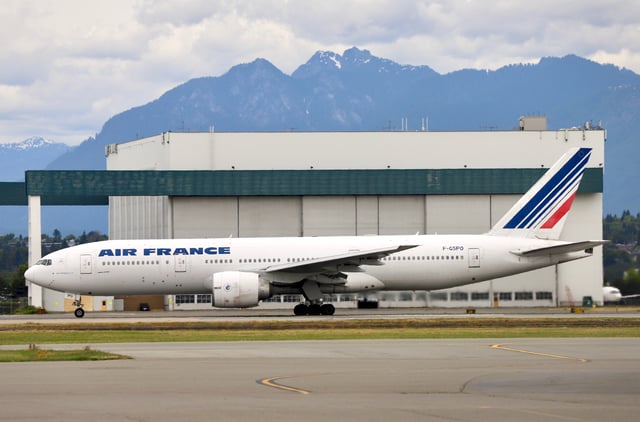
Air France 777-200ER taking off from Vancouver International Airport
On 12 January 2012, Air France-KLM announced a three-year transformation plan, called Transform 2015, to restore profitability. The plan was to restore competitiveness through cost-cutting, restructuring the short- and medium-haul operations and rapidly reducing debt. The main objective of this plan was to turn Air France-KLM back into a world player by 2015. Air France had been losing 700 million euros a year. As the financial results of 2011 demonstrated, the long-haul operations, also subject to increasing competition, would not be able to offset these losses. On 22 February 2012, Air France released its plan for the summer schedule. Because of the uncertain economic environment, Air France-KLM set a limit of 1.4% maximum increase in capacity from 25 March 2012 – 28 October 2012.[34][35][36]
On 21 June 2012, Air France-KLM had announced its decision to cut just under 10% of the total 53,000 workforce (about 5,000 jobs) by the end of 2013 in an attempt to restore profitability. The airline expected to lose 1,700 jobs through natural turnover and the rest by voluntary redundancies.[37] As of August 2012, the Transform 2015 plan was accepted by ground staff and pilot unions but rejected by cabin crew unions.[38]
At the beginning of July 2012, it was announced that Air France-KLM found partners for the new African start-up airline Air france, which was co-founded by six countries in Central Africa to replace the former Air Afrique. But several problems and two partners, who decided to back out, delayed the implementation of the project. Following its launch, Air france announced it would commence operations in 2013.[39]
In September 2013, Air France introduced a brand new Economy product along with an improved Premium Economy seat and service. It is expected that the new improvements would be fitted on aircraft from June 2014 onwards.[40] In October 2013, Air France-KLM announced it was writing off the 25% stake in Alitalia, as it was hesitant the struggling carrier would obtain the 300 million euros in financing. The group has denied Alitalia of additional funds as it is currently struggling to restructure itself to profitability with the Transform 2015 plan.[41]
In December 2013, Air France announced that Cityjet no longer meets the short haul needs of the group and is in the process of closing a deal with German firm Intro Aviation by the end of Q1 of 2014.[42]
On 4 February 2014, the new business product was unveiled, featuring a fully flat bed from Zodiac Aerospace. The seat was fitted on Boeing 777 aircraft from June 2014 onwards.[47] In September 2014, Air France announced it would sell a 3 percent stake in travel technology company Amadeus IT Group for $438 million.[48]
Late in 2015, Air France faced a financial crisis, which was exacerbated by a pilot's strike against the airline. The airline answered the strike by announcing it would cut some 2,900 jobs.[49] In December 2015, Air France announced the retirement of its last Boeing 747-400 with a special scenic flight on 14 January 2016. The airline operated the 747 in several variants since 1970.[50]
In January 2017, Air France received its first Boeing 787-9.
In November 2017, CityJet no longer operated on Air France flights and the affected destinations were served by Air France and HOP! from then on.[51]
In July 2017, Air France-KLM entered into a multi-airline strategic partnership with Delta Air Lines, China Eastern Airlines and Virgin Atlantic Airways, solidifying the existing ties between the carriers. Under the agreement Delta and China Eastern would each buy 10% of Air France-KLM, while Air France-KLM would buy 31% of Virgin Atlantic.[52]
Air France announced it would terminate services to Iran from September 2018, explaining the concern that the route to Iran is no longer commercially viable due to the redefined US sanctions.[53]
Corporate affairs and identity
Head office

Head office of Air France in Roissypôle, Charles de Gaulle Airport, Tremblay-en-France
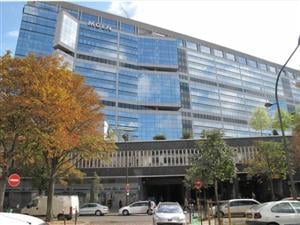
Former head office, Square Max Hymans
Air France's head office is located in the Roissypôle complex on the grounds of Charles de Gaulle Airport and in the commune of Tremblay-en-France, Seine-Saint-Denis, near the city of Paris.[54][55][56][57][58] Wil S. Hylton of The New York Times described the facility as "a huge white box that squats near the runways at Charles de Gaulle Airport."[59]
The 130,000 square metres (1,400,000 sq ft) complex was completed in December 1995. The French firm Groupement d'Etudes et de Méthodes d'Ordonnancement (GEMO) managed the project. The architect was Valode & Pistre and the design consultants were Sechaud-Boyssut and Trouvin. The project cost 137,000,000 euros[56] (less than 700 million francs[60]). The runways of the airport are visible from the building.[61] The Air France Operations Control Centre (OCC, French: Centre de Contrôle des Opérations, CCO), which coordinates Air France flights worldwide, is situated at the AF head office.[62][63]
For about 30 years prior to December 1995, Air France's headquarters were located in a tower adjacent to the Gare Montparnasse rail station in the Montparnasse area and the 15th arrondissement of Paris.[64] By 1991 two bids for the purchase of the Square Max Hymans building had been made.[65] By 1992 the complex was sold to Mutuelle générale de l'Éducation nationale (MGEN) for 1.6 billion francs.[66] By that year Air France had planned to move its head office to Roissypôle,[67] taking 50,000 square metres (540,000 sq ft) of space inside the hotel, office, and shopping complex on the grounds of Charles de Gaulle Airport.[68] After Air France moved to Tremblay-en-France, the ownership of the former head office complex was transferred.[69]
On a previous occasion the head office was at 2 rue marbeuf in the 8th arrondissement of Paris.[70]
Foreign offices
Air France's United States offices are in the 125 West 55th Street building in Midtown Manhattan, New York City.[71] Air France first signed a lease to occupy the building in 1991.[72] The site also formerly housed the New York City city ticket office for Air France.
Air France-KLM's head office for the United Kingdom and Ireland operations, which includes facilities for Air France and KLM, is located in Plesman House in Hatton Cross. The facility's inauguration was on 6 July 2006. Air France moved the office from Hounslow to Hatton.[73]
Crew base
Air France Cité PN, located at Charles de Gaulle Airport, acts as the airline's crew base. The building, developed by Valode & Pistre, opened in February 2006. The first phase consisted of 33,400 square metres (360,000 sq ft) of space and 4,300 parking spaces. The building is connected to the Air France head office.[74]
Vaccination centre
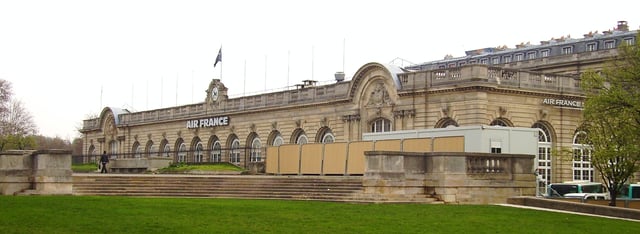
Aérogare des Invalides, 7th arrondissement, Paris
Air France operates the Air France Vaccinations Centre in the 7th arrondissement of Paris.[75][76] The centre distributes vaccines for international travel. Since 2001 the centre was the only French vaccination centre certified International Organization for Standardization (ISO) 9001.[77] In 2005 the centre moved from the Aérogare des Invalides to its current location.[78]
Aérogare des Invalides
The Aérogare des Invalides in the 7th arrondissement of Paris houses the Agence Air France Invalides and the Air France Museum.[79][80] Until 2005 the building hosted the Air France Vaccinations Centre.[78] On 28 August 1959 Air France opened a ticket and information agency in the former air terminal in Invalides, targeting transit passengers and customers from offices and companies in the Invalides area.[81]
Subsidiaries and franchises
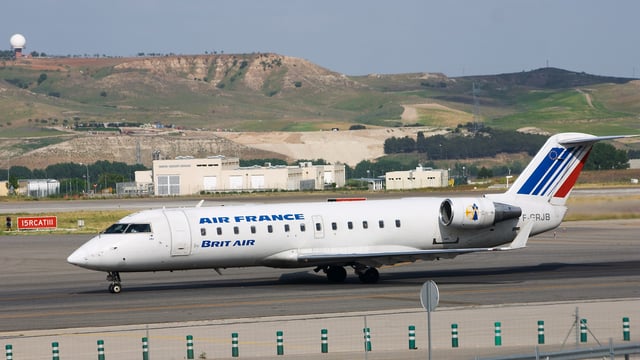
Air France regional jet operated by Brit Air, now HOP!
The subsidiaries of Air France include:[82]
Air France Consulting Quali-audit[83]
BlueLink
HOP!
Servair
Société de construction et de réparation de matériel aéronautique (CRMA)
Sodexi
Air France and Dutch affiliate Transavia formed Transavia France, a low-cost joint venture in May 2007, based at Orly Airport.[84] Air Corsica, CityJet and HOP! all operate flights on behalf of Air France, either as subsidiaries or as franchisees.
As of January 2019, Air France was investigating how it could shut down its low-cost subsidiary Joon and absorb its employees and aircraft into the parent company.[85]
Air France Asie and Air France Cargo Asie
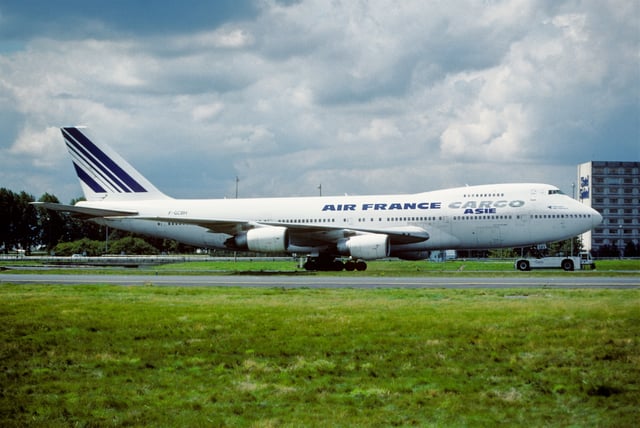
Air France Cargo Asie Boeing 747-200F
Owing to the disputed status of Taiwan, Air France could not operate flights to the island under its own name. In 1993, its subsidiary, Air Charter, began operating flights between Paris and Taipei via Hong Kong,[86] but after Air Charter ceased operations in 1998, a subsidiary called Air France Asie was established.[87] The airline was one of a number of airline subsidiaries flying under the "Asia" name with the purpose of flying to Taiwan, which included Japan Asia Airways (a Japan Airlines subsidiary), KLM Asia, British Asia Airways, Swissair Asia, and Australia Asia Airlines (a Qantas subsidiary).
The livery of Air France Asie differed from that of Air France by having blue and white stripes on the tailfin, rather than blue, white and red ones, representing the French Tricolour. Air France Asie used two Airbus A340-200 aircraft, F-GLZD and F-GLZE, and two Boeing 747-428Ms, F-GISA and F-GISC. Similarly, Air France Cargo Asie used a 747-200 Combi (for passengers and freight), F-GCBH) or the all-cargo (F-GCBL, F-GPAN and F-GBOX). Air France Asie ceased operations in 2004 while Air France Cargo Asie ceased operations in 2007.
Outsourcing
In 2010 Air France migrated from an internally managed Passenger service system (Alpha3) that manages reservation, inventory and pricing to an external system (Altéa) managed by Amadeus. In rail ventures, Air France and Veolia are looking into jointly operating high-speed rail services in Europe. Routes have become available to operators in accordance with European rail liberalisation on 1 January 2010.[88]
Livery

Old livery and New livery
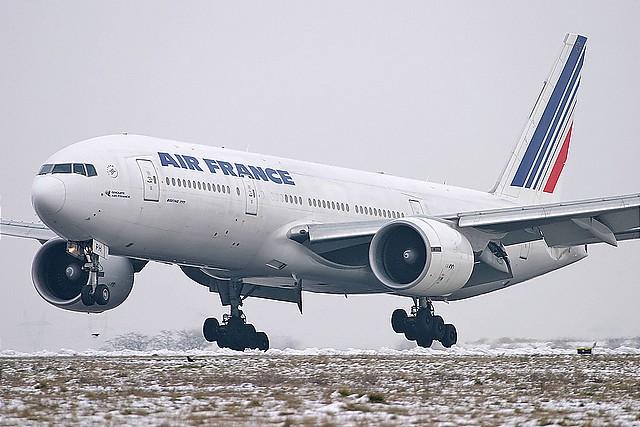
Boeing 777-200ER with Air France's Eurowhite 1970s–2008 livery
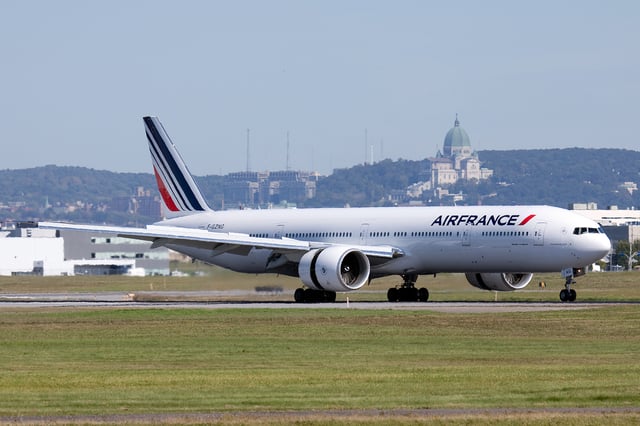
Air France Boeing 777-300ER in the new livery landing at Montreal-Trudeau
Air France's present livery is a "Eurowhite" scheme, comprising a white fuselage with the blue Air France title and design. The tail is white with a series of parallel red and blue lines across the tail at an angle, and a small European flag at the top. This livery has been in use since the late 1970s. Prior to the "Eurowhite" livery, Air France aircraft had a bare-metal underside, extending up to a blue cheat-line that ran across the cabin windows. Above the cheat-line the fuselage was again white, with Air France titles and a French flag. The tail was white with two thick blue lines, which tapered from the rear of the tail and met at point towards the front bottom. This basic livery, with minor variations, would appear on all post-war Air France aircraft until the late 1970s.
On January 2009, to coincide with Air France's new logo, a new livery was unveiled.[89] Air France rolled out its new livery on 11 February 2009. The 2009 livery saw the tail slightly changed; there are now 3 blue bars running down instead of 4 previously. The bars also now curve at the bottom, reflecting the design of the logo.
Marketing
The new official song played before and after Air France flights (during boarding and after landing) is 'The World Can Be Yours' by Telepopmusik. Air France has used different popular music groups for its marketing and on-board ambience, ranging from The Chemical Brothers in 1999 to Telepopmusik in 2010.[90]
Air France launched a new ad campaign in 2015 designed by BETC and directed by We Are From LA, focusing on French culture. Along with the ad campaign and print ads, Air France also introduced a similarly themed safety video. The music is a customised version of Glass Candy's song Warm in the Winter.[91]
Uniforms
Air France uniforms denote the ranks for the flight attendants. Two silver sleeve stripes denote a Chief Purser. One silver sleeve stripe denote a Purser. Flight attendants do not have any sleeve stripes. The female cabin crew uniforms feature the stripes on the breast pocket rather than the sleeve for their male counterparts. Air France's current uniforms were created by French fashion designer Christian Lacroix.[92]
Branding
Upon its formation, Air France adopted the seahorse logo of its predecessor Air Orient, known as the hippocampe ailé (sometimes derisively called "la crevette" – or shrimp – by its employees), as its insignia.[93][94] Prior to the Air France-KLM merger, the hippocampe ailé was used on the nose section of aircraft next to the Groupe Air France title; after the merger, the Air France-KLM logo was substituted at the nose area, and the hippocampe ailé was relocated to engine nacelles. The acronym "AF" has also featured prominently on the airline's flag and its signage. On 7 January 2009, Air France officially changed its logo to a red stripe.
Destinations
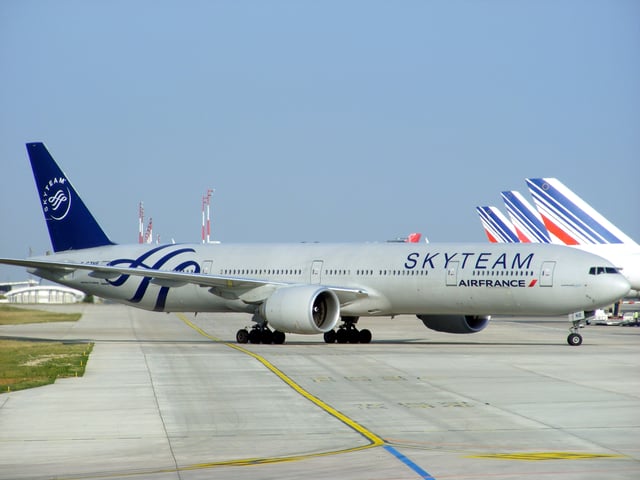
An Air France Boeing 777-300ER specially painted in SkyTeam livery to commemorate the airline's membership
As of 2011, Air France flies to 36 domestic destinations and 168 international destinations in 93 countries (including Overseas departments and territories of France) across 6 continents. This includes Air France Cargo services and destinations served by franchisees Air Corsica, CityJet and HOP!. Most of Air France's international flights operate from Paris-Charles de Gaulle. Air France also has a strong presence at Paris-Orly, Lyon-Saint-Exupéry, Marseilles Provence, Toulouse Blagnac, Nice Côte d'Azur and Bordeaux-Merignac airports.
Hub information
Charles de Gaulle Airport: Air France's intercontinental and biggest hub, with 335 daily departures. It is also a hub for Air France's subsidiary HOP!.
Orly Airport: Air France's second biggest hub serving 40 destinations around the world, it is also a hub for Air France's subsidiary HOP!. Long-haul flights are mainly operated to destinations in French overseas departments.
Lyon-Saint Exupéry Airport: Air France's third biggest hub serving 37 destinations in France and Europe, also a hub for Air France's subsidiary HOP!.
Marseille Provence Airport: This is Air France's newest hub as part of its offensive in the French regions. It serves 30 destinations in France, Europe and Africa.
Nice Côte d'Azur Airport: Air France flies to four destinations from Nice.
Toulouse-Blagnac Airport: Air France flies to 14 destinations from Toulouse.
Codeshare agreements
Air France codeshares with the following airlines:[95]
Adria Airways
Aeroflot
Aerolíneas Argentinas
Aeroméxico
Air Antilles
Air Astana
Air Austral
Air Burkina
Air Corsica
Air Europa
Air Malta
Air Mauritius
Air Serbia
Air Seychelles
Air Tahiti Nui
airBaltic
Aircalin
Alitalia
AtlasGlobal
Austrian Airlines
Azerbaijan Airlines
Bangkok Airways
Belavia
Bulgaria Air
China Eastern Airlines
China Southern Airlines
CityJet
Comair
Croatia Airlines
Czech Airlines
Etihad Airways
Finnair
Flybe
Garuda Indonesia
Georgian Airways
HOP!
Kenya Airways
KLM
Korean Air
LATAM Brasil
Luxair
Middle East Airlines
MNG Airlines
Montenegro Airlines
Qantas[96]
Saudia
Swiss International Air Lines
TAAG Angola Airlines
TAROM
Ukraine International Airlines
Vietnam Airlines
WestJet
Winair
Fleet
Current fleet
| Air France Passenger Fleet | ||||||||
|---|---|---|---|---|---|---|---|---|
| Aircraft | In Service | Orders | Passengers | Notes | ||||
| F | J | W | Y | Total | ||||
| Airbus A220-300 | — | 60[101] | — | — | — | 149 | 149 | Deliveries starting in September 2021.[101] Order includes 30 options and 30 purchase rights. |
| Airbus A318-100 | 18 | — | — | — | — | 131 | 131 | To be replaced by A220-300 |
| 18 | 113 | 131 | ||||||
| Airbus A319-100 | 33 | — | — | — | — | 142 | 142 | To be replaced by A220-300 |
| 143 | 143 | |||||||
| 20 | 123 | 143 | ||||||
| Airbus A320-200 | 43 | — | — | 14 | — | 144 | 168 | Two in SkyTeam livery |
| — | 174 | 174 | ||||||
| 36 | 138 | 174 | ||||||
| — | 178 | 178 | ||||||
| Airbus A321-100 | 5 | — | — | — | — | 212 | 212 | Former Air Inter fleet. |
| Airbus A321-200 | 15 | — | — | — | — | 200 | 200 | One in SkyTeam livery |
| — | 212 | 212 | ||||||
| 36 | 176 | 212 | ||||||
| Airbus A330-200 | 15 | — | — | 40 | 21 | 147 | 208 | To be reconfigured with 224-seat configuration by 2020.[102] |
| 36 | 167 | 224[102] | ||||||
| Airbus A340-300 | 5[103] | — | — | 30 | 21 | 224 | 275 | To be replaced by A350-900 |
| 227 | 278 | |||||||
| Airbus A350-900 | — | 28[104][105] | — | 34 | 24 | 266 | 324[106] | Entering service in 2019. To replace Airbus A340-300, older Boeing 777 Family[107] |
| Airbus A380-800 | 10 | — | 9 | 80 | 38 | 389 | 516 | All aircraft are to be retired and transferred to another airline by 2022[101] |
| Boeing 777-200ER | 25 | — | — | 40 | 24 | 216 | 280 | Older aircraft are to be replaced by Airbus A350-900 |
| 28 | 260 | 312 | ||||||
| 16 | 276 | 316 | ||||||
| Boeing 777-300ER | 43 | — | 4 | 58 | 28 | 206 | 296 | Launch customer Three in SkyTeam livery |
| 38 | 252 | 322 | ||||||
| — | 42 | 24 | 315 | 381 | ||||
| 14 | 32 | 422 | 468 | |||||
| Boeing 787-9 | 9 | 1 | — | 30 | 21 | 225 | 276 | Deliveries through May 2020[108] |
| Air France Cargo Fleet | ||||||||
| Boeing 777F | 2 | — | Cargo | Launch customer | ||||
| Total | 222 | 89 | ||||||
Orders
On 16 September 2011, Air France-KLM announced orders for 50 Airbus A350s and Boeing 787s with 60 options, to be operated by both Air France and KLM.[109] The first Boeing 787-9 entered into service with KLM in 2015 and with Air France in early 2017.[110] In June 2019 the company announced a revision of the original order with Air France becoming the sole operator of the Airbus A350, with KLM only operating Boeing 787s.
Airbus A380
Air France signed as a launch customer for the Airbus A380-800 "superjumbo" in 2001.[111] Air France had ordered 12 Airbus A380-800 aircraft, with options on a further two. Air France was the first airline in Europe to operate the A380. The first A380 was delivered on 30 October 2009, and the Paris to New York route was used as the first route. All of Air France's Airbus A380s depart from the airline's international hub at Charles de Gaulle Airport in Terminal 2E (Main Terminal, Satellites 3 and 4). In 2018, the Chairman and CEO of Air France-KLM, Benjamin Smith announced the airline would retire 50% of the Airbus A380 fleet by 2021 due to expensive costs, poor efficiency, and in favor of adding more Airbus A350-900s and Boeing 787 Dreamliners to the fleet. Air France is only retiring the five aircraft that were leased to the airline by not renewing their leases and instead of returning them to directly to Airbus. The five Airbus A380 aircraft bought by Air France will continue service from 2020 onwards with renewed cabins.[112] On 23 June 2019, Air France-KLM began considering removing all of their Airbus A380s earlier than planned due to concerns that investments for cabin retrofitting and economics won't work. This means that if Air France-KLM makes the decision to remove all their Airbus A380s earlier than planned, the non-leased Airbus A380s will never be seen with retrofitted and modernized cabins.[113] In August 2019, Air France-KLM revised retirement plans on the Airbus A380 and announced that the entire Airbus A380 fleet would be retired by 2022. This will lead to Air France-KLM eliminating all quad-jet planes from their fleet by 2022 with the exception of the three KLM Cargo Boeing 747-400ERFs operated by Martinair. Instead Air France-KLM will evaluate the Airbus A330neo aircraft and/or additional Airbus A350s and Boeing 787s as replacement aircraft to replace the A380 fleet instead their original plan of refurbishing 50% of the Airbus A380 fleet with modernized cabins.[101]
Widebody fleet
Air France-KLM has a commitment for 37 Boeing 787s, 25 directly and 12 leased, of which 16 are earmarked for Air France to replace some A340-300s. Subsequent A340s would be replaced by Airbus A350s from 2019; Air France-KLM has 28 A350s on firm order.[114]
Narrowbody fleet
As of 2018 Air France had not decided how its narrowbody fleet should be replaced: it operates 117 Airbus A320 family aircraft.[114]
Fleet history
| Aircraft | Total | Introduced | Retired | Replacement | Notes | Refs |
|---|---|---|---|---|---|---|
| Aérospatiale/BAC Concorde | 7 | 1976 | 2003 | None | One crashed as Air France Flight 4590 | |
| Airbus A300B2-100 | 9 | 1974 | 1986 | Airbus A330-200 | ||
| Airbus A300B4-200 | 16 | 1976 | 1998 | Airbus A330-200 | ||
| Airbus A310-200 | 7 | 1984 | 2002 | Airbus A330-200 | ||
| Airbus A310-300 | 4 | 1989 | 2002 | Airbus A330-200 | ||
| Airbus A320-100 | 14 | 1988 | 2008 | Airbus A320-200 | ||
| Airbus A340-200 | 6 | 1993 | 1999 | Airbus A340-300 | ||
| Airbus A340-300 | 15 | 1993 | 2019 | Boeing 787-9 | ||
| Amiot AAC.1 Toucan (Junkers Ju 52/3m) | Unknown | 1945 | 1953 | Unknown | ||
| Boeing 707-320B | Unknown | 1960 | 1982 | Airbus A300 | ||
| Boeing 707-320C | Unknown | 1960 | 1984 | Airbus A310 | ||
| Boeing 707-320 Intercontinental | Unknown | 1959 | 1979 | Airbus A300 | ||
| Boeing 727-200 | Unknown | 1968 | Unknown | Airbus A320-200 | ||
| Boeing 737-200 | 24 | 1982 | 2002 | Airbus A320-200 | ||
| Boeing 737-300 | 9 | 1991 | 2004 | Airbus A320-200 | ||
| Boeing 737-500 | 30 | 1990 | 2007 | Airbus A320-200 | ||
| Boeing 747-100 | 17 | 1970 | 2008 | Airbus A330-200 | ||
| Boeing 747-200B | 2 | 1977 | 2005 | Boeing 747-400 Airbus A330-200 | ||
| Boeing 747-200F | 11 | 1974 | 2003 | Boeing 747-400ERF | ||
| Boeing 747-200M | 16 | 1977 | 2005 | Boeing 747-400M | ||
| Boeing 747-200M/SUD | 2 | 1992 | 2007 | Boeing 747-400M | Acquired from Union des Transports Aériens Converted from two 747-200M aircraft. | |
| Boeing 747-300 | 3 | 1991 | 2007 | Boeing 747-400 Airbus A330-200 | Acquired from Union des Transports Aériens. | |
| Boeing 747-300M | 1 | 1991 | 2007 | Boeing 747-400 | ||
| Boeing 747-400 | 14 | 1991 | 2016 | Airbus A380-800 Boeing 777-300ER | Four aircraft were converted into freighters | |
| Boeing 747-400BCF | 4 | 2009 | 2011 | Boeing 777F | Converted from 747-400 passenger aircraft. | |
| Boeing 747-400ERF | 6 | 2002 | 2015 | Boeing 777F | ||
| Boeing 747-400M | 3 | 1992 | 2012 | Boeing 777-300ER | ||
| Boeing 767-200ER | 2 | 1991 | 1992 | None | ||
| Boeing 767-300ER | 8 | 1991 | 2003 | Boeing 777-300ER | ||
| Breguet Deux-Ponts | Unknown | 1952 | 1971 | Unknown | ||
| de Havilland Comet | Unknown | 1953 | 1954 | Boeing 707 | ||
| Douglas DC-3 | Unknown | 1946 | 1962 | Unknown | ||
| Douglas DC-4 | Unknown | 1946 | 1971 | Unknown | ||
| Douglas DC-6 | Unknown | 1949 | 1968 | Unknown | ||
| Fokker F27 Friendship | Unknown | 1967 | 1997 | Unknown | ||
| Fokker 100 | Unknown | 1997 | 1999 | Unknown | ||
| Junkers Ju 52/3m | Unknown | 1945 | 1953 | Unknown | ||
| Latécoère 631 | Unknown | 1947 | Unknown | Unknown | ||
| Lockheed L-049 Constellation | Unknown | 1946 | 1950 | Lockheed L-1049 Super Constellation | ||
| Lockheed L-749 Constellation | Unknown | 1947 | 1961 | Lockheed L-1049 Super Constellation | ||
| Lockheed L-1049 Super Constellation | Unknown | 1953 | 1968 | Lockheed L-1649A Starliner | ||
| Lockheed L-1649A Starliner | Unknown | 1957 | 1963 | Unknown | ||
| Lockheed L-1011 TriStar | Unknown | 1989 | 1991 | Unknown | ||
| McDonnell Douglas DC-10-30 | 5 | 1992 | 1995 | Unknown | ||
| SNCASE Languedoc | Unknown | 1945 | 1952 | Unknown | ||
| Sud-Ouest Bretagne | Unknown | Unknown | Unknown | Unknown | ||
| Sud Aviation SE 210 Caravelle | Unknown | 1959 | 1981 | Unknown | ||
| Transall C-160 | Unknown | 1973 | 1978 | Unknown | ||
| Vickers Viscount 700 | Unknown | 1953 | 1968 | Unknown |
Concorde
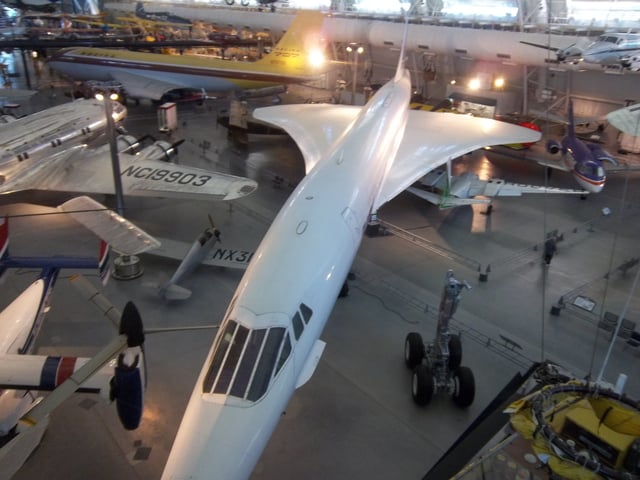
Aerial view of Air France Concorde F-BVFA at the Steven F. Udvar-Hazy Center in Virginia
The five Air France Concordes were retired on 31 May 2003, as a result of insufficient demand following the 25 July 2000 crash of AF Concorde F-BTSC, at Gonesse (near Charles de Gaulle Airport), as well as higher fuel and maintenance costs. British Airways flew its last Concorde service on 24 October 2003. Concorde F-BVFA was transferred to the Steven F. Udvar-Hazy Center at Washington Dulles International Airport. F-BVFB was given to the Sinsheim Auto & Technik Museum in Germany, F-BTSD to the Musée de l'Air et de l'Espace at Le Bourget Airport in Paris, while F-BVFC returned to its place of manufacture in Toulouse, at the Airbus factory. F-BVFF is the only example to remain at Charles de Gaulle Airport.
Boeing 747
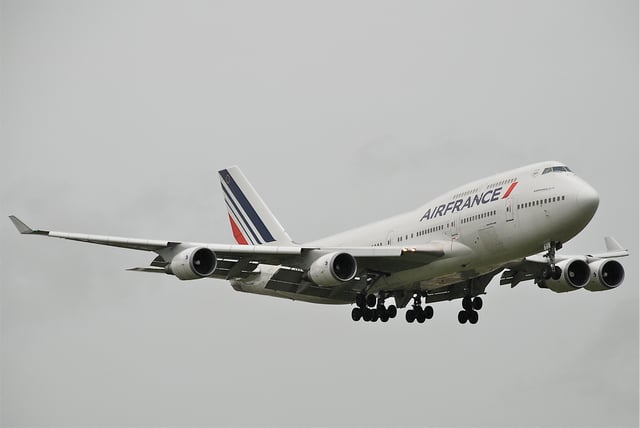
A retired Air France Boeing 747-400
The airline started operating the 747 on 3 June 1970, when a 747-100 was put into service that was delivered 20 March that year.[118] It would go on to operate the -200, -300 and -400 variants. In January 2016, Air France finally retired its last Boeing 747-400. They were replaced by Airbus A380s and Boeing 777-300ERs. Freighter versions were replaced by Boeing 777Fs.[119][120]
Cabin

La Première seats on a Boeing 777
Air France offers a mix of three and four cabin configurations for international long haul routes, featuring La Première (select aircraft), Business, Premium Economy and Economy. Personal screens with audio video on demand is available in all cabins on all long-haul aircraft. European short-haul and medium-haul flights feature a three cabin configuration with Business, Premium Economy, and Economy.
La Première
La Première, Air France's long-haul first class product, is available on the Airbus A380-800 and selected Boeing 777-300ER aircraft.[121] The Première cabin features wood and leather seats which recline 180°, forming two-metre long beds. Each seat features a 10.4" touchscreen personal screen with interactive gaming and audio video on demand, a privacy divider, automassage feature, reading light, storage drawer, noise-cancelling headphones, personal telephone, and laptop power ports. Each passenger is also provided with a personalised coat service, pure merino wool blanket, a "boudoir-style" cushion, and a travel kit featuring Biologique Recherche facial and body care products to moisturize and refresh the skin. Turndown service includes a mattress, a duvet, hypoallergenic feather pillow, sleepwear, a dust bag for shoes, and a pair of slippers[122] À la carte on-demand meal services feature entrées created by Chef Guy Martin. Private lounge access is offered worldwide featuring a chauffeured car to the aircraft. La Première is not available on the Airbus A330-200, Airbus A340-300, Boeing 777-200ER and selected Boeing 777-300ER aircraft where Business is the highest cabin class. Four-class 777-200ER and 777-300ER configurations are equipped with four and eight La Première seats respectively, while the Airbus A380 feature 9 La Première seats.
Business
Business, Air France's long-haul business class product, is available on all long haul aircraft. Business features angled lie-flat seats which recline to two metres in length. Each seat includes a 10.4" touchscreen TV monitor with interactive gaming and AVOD, reading light, personal telephone, and laptop power ports. Meal service features three-course meals and a cheese service, or an express menu served shortly after takeoff.
Air France has released a brand new business class product, the seat is a Zodiac Aerospace Cirrus and is designed by Mark Collins of Design Investment, specialized in the world of high-end transportation and by the design and branding agency, Brandimage. The new seat would be installed on the Boeing 777 aircraft from June 2014 until summer 2016, all other aircraft types would then be retrofitted except for the Boeing 747-400 and Airbus A340-300 as they were to be retired from the fleet by 2016 and 2019 respectively. A total of 2,102 seats would be installed. The new cabin features a 1-2-1 layout as opposed to the 2-3-2 layout found currently on the 777. The new 16-inch (41 cm) screen offers a unique onboard navigation experience similar to a tablet. With a completely redesigned user interface and available in 12 languages (French, English, Spanish, Brazilian Portuguese, Chinese, Japanese, Korean, German, Italian, Dutch, Russian and Arabic), choosing an entertainment program from over 1,000 hours of entertainment. The seat converts into a fully flat bed with 180 degrees recline, it features a touchscreen remote control, USB port, universal electrical outlet, new noise cancelling headphones, privacy screen, an Air France signature padded headboard, ample storage space, adjustable headrest, and a duvet with XXL feather down pillow.[123]
Premium Economy
Premium Economy, is Air France's premium economy product for long haul flights, which became available on the Boeing 777-200ER, 777-300ER, Airbus A340-300 and Airbus A330-200 in late 2009 and early 2010, and on the A380-800 in late 2010 and early 2011. It is a dedicated cabin section with a 2-4-2 (2-3-2 on the long haul Airbus fleet and 3-3-3 for Alize on the 777-300 serving Indian Ocean and Caribbean routes) configuration with 38″ pitch (36″ for long haul Alize seats), 123° reclining fixed shell seats, including an adjustable headrest, a 10.4″ touchscreen, personal reading lamp, universal power ports, and an adjustable leg rest (40% more space, compared to Voyageur seats; the seats are 20% wider and offer 20% more legroom). There are 38 seats on the Airbus A380, 32 on the Boeing 777-300ER, 24 on the Boeing 777-200 and 21 on the Airbus A340-300 & A330-200 (between the Business and Economy cabin; behind Business on the A380 upper deck).[124] Passengers receive double baggage allowance, priority airport services, lounge access (for a fee), and extra frequent flier mileage. On board, business class amenities include Sennheiser noise-cancelling headphones, an amenity kit (featuring socks, eye mask, toothbrush & toothpaste, and earplugs), improved blankets, and an enhanced meal service with second hot meal, candies, and ice-cream all served with real glass and metal cutlery.[125] A new improved Premium Economy seat using the same shell was introduced from June 2014 on the Boeing 777 aircraft, featuring better cushioning and improved foot rest, adding comfort to the passenger.[40]
Economy
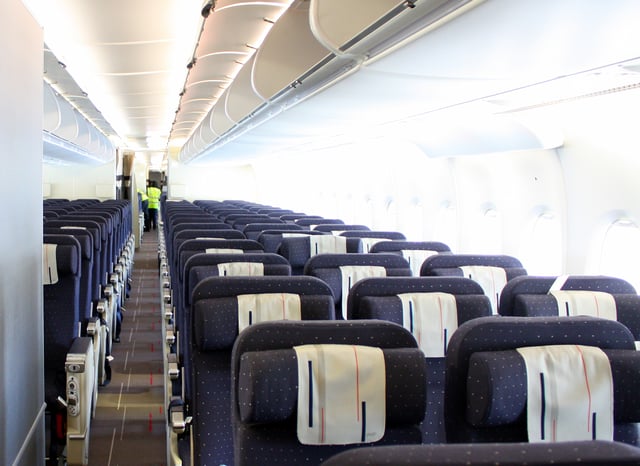
Economy cabin on an Airbus A380
Economy, Air France's economy class long haul product, features seats that recline up to 118°. The current long-haul Economy seat, which debuted on the Boeing 777-300ER, includes winged headrests, a personal telephone, and a touchscreen TV monitor with AVOD Interactive Entertainment System which have been installed on all of Air France's long haul fleet. On long haul flights, a menu is presented with a choice of two meals. Short and medium haul Economy services are operated by Airbus A320 family aircraft with different seating arrangements. Air France is one of the few airlines who features winged headrests on short to medium haul aircraft in both classes. On short haul flights a snack is served, while on medium haul flights a three course cold meal is served. Free alcoholic beverages are available on all flights, including champagne.[126][127] On most aircraft, Air France offers extra legroom seats in economy called Seat Plus. These seats are located in the economy class exit rows and other rows depending on the plane, as well as the economy seats on the 747's upper deck, offering at least 4" more seat pitch(36" versus the usual 32" in standard economy seats), the 747's Seat Plus section also provides an extra half-inch of seat width. Seat Plus prices vary by flight time, but it is free to elites and passengers with a full fare economy ticket.
Air France has introduced a brand new economy long haul product which features a new slimline seat providing up to an inch more legroom, wider table, universal electrical sockets, retractable armrests, winged leather headrests, more storage space, high definition 10-inch screens featuring the latest in flight entertainment with a USB port, a headphones holder, and newly designed pillows featuring different patterns of the Air France logo. The seats would be installed along with the new La Première, Business, and Premium Economy seats from June 2014 till summer 2016 on the Boeing 777 aircraft, the core of the fleet. All other aircraft would be retrofitted except the Airbus A340-300s and Boeing 747-400s as they would be leaving the fleet soon.[128]
Services
In-flight catering
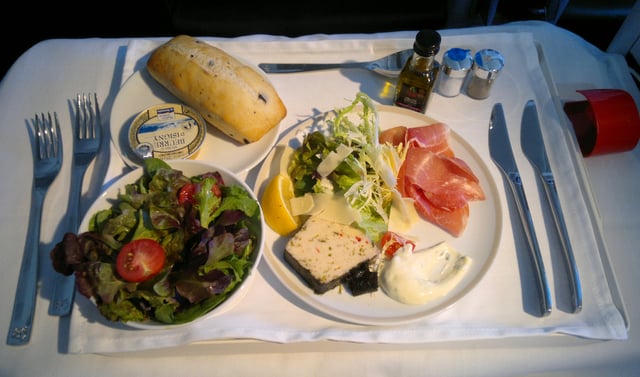
Gourmet appetizer and seasonal salad in Business
For La Première, Air France's first class menu is designed by Guy Martin, chef of Le Grand Vefour, a Michelin three-star restaurant in Paris.[129] Menu items include hors d'oeuvres, entrées, bread basket, and cheeses, along with a dessert cart including pastries, petit fours, and tartlets.[130] On long-haul flights, Air France also serves complimentary champagne to passengers in all classes.
In-flight entertainment
Air France offers Audio Video on Demand (AVOD) in all cabins on all long haul aircraft. The in flight entertainment system features multiple channels of video, audio, music, and games. Air France Magazine, the airline's in-flight publication, is included at each seat, and Air France Madame, a fashion luxury magazine with a feminine perspective, is included in La Première and Business cabins and lounges.[131] On all flights, all films may be watched in English, Spanish, and French. Selected films on all flights are also available in Chinese, Japanese, Hindi, and Korean. The airline offers Berlitz International language courses via the in-flight entertainment system.[132]
On 29 May 2013, KLM and Air France launched a pilot to test inflight Wi-Fi. Both airlines have equipped one Boeing 777-300ER of each of their fleets with Wi-Fi. Using the inflight Wi-Fi, passengers can stay online using their Wi-Fi enabled smartphones, laptops, or tablets. Wireless service would commence once the flight has reached 20,000 feet.[133]
Le Salon
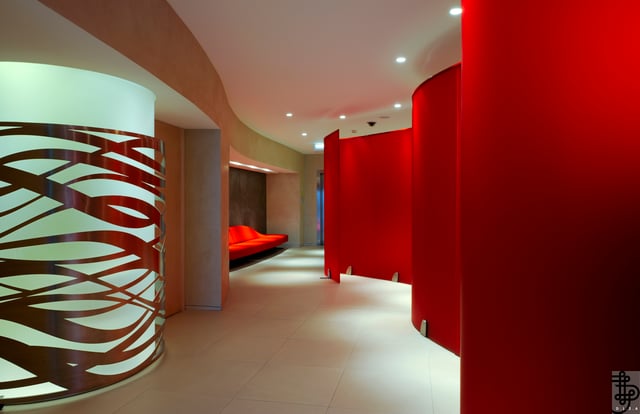
Air France Le Salon La Première
Air France lounges are known as Le Salon, and are open to La Première, Business, and Premium Economy passengers, as well as Flying Blue Gold, Flying Blue Platinum, SkyTeam Elite and Elite Plus members. Worldwide, there are 530 Air France and Skyteam lounges in 300 international airports on every continent except Antarctica.[134]
Flying Blue
Flying Blue, the frequent flyer program of Air France-KLM, awards members points based on miles travelled and class of service. Membership into the program is free. The program is divided into standard (Explorer), Elite (Silver) and Elite Plus (Gold and Platinum) statuses. Explorer is the basic level which is attained upon entry into the program. Elite status is attained by accruing a certain number of miles within one calendar year. Elite Silver, Elite Plus Gold, and Elite Plus Platinum cards have added benefits. An invitation-only card called Club 2000 is attributed to some VIPs, celebrities and politicians.[135] Officially, it provides the same benefits as Platinum status but numerous sources confirm it almost guarantees upgrade to Business or La Première.[136] Flying Blue succeeded Air France's previous frequent flyer program, Fréquence Plus, which operated until the Air France-KLM merger in 2003.[137]
In popular culture
Anniversary jet
On 14 November 2008, Air France released the first picture[140] of an Airbus A320 that had been repainted in the full 1946 paint scheme[141] to celebrate the airline's 75th anniversary. This heritage aircraft was planned to fly under the special colours until early 2010.[142] In 2013 the aircraft was withdrawn from use for scrapping,[143]
Incidents and accidents
See also
Dirigisme
List of airlines of France
List of airports in France
List of companies of France
Transport in France
Air transport in France
